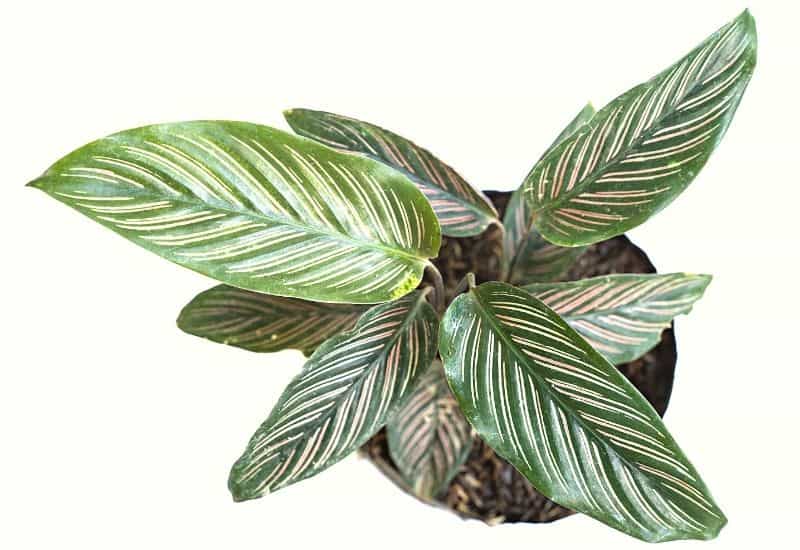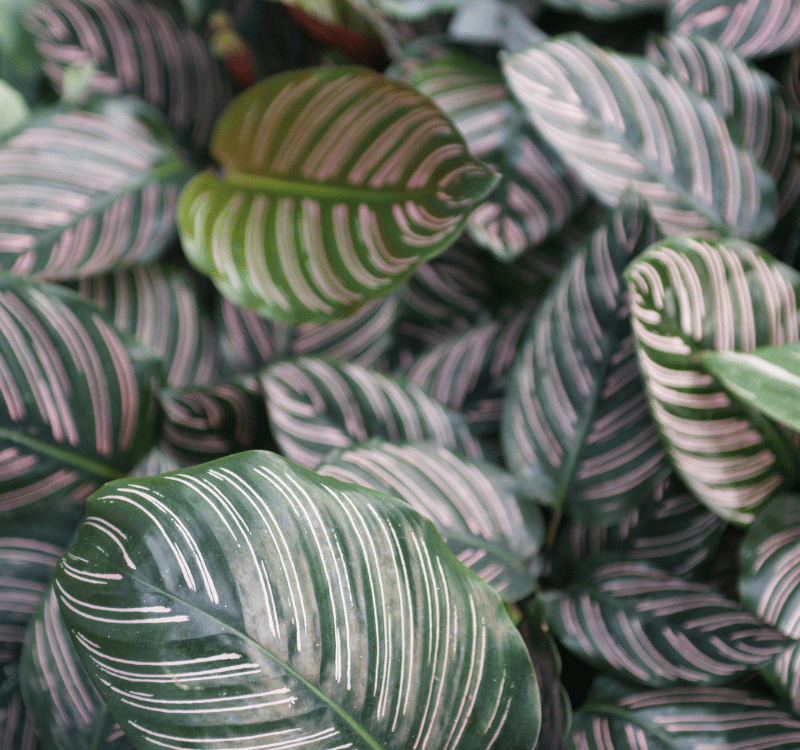With over 4,000 species of calathea, it can be pretty hard to determine the proper care for your plant.
Calathea Ornata is one of the most common species in cultivation which is relatively easy to grow. Attempt to let this article help you take good care of your plant!
Calathea Ornata Care Guide Overview
- How To Plant (when & where)
- How To Grow (staking, watering, fertilizing, humidity, mulching)
- How To Trim And Prune
- How To Propagate (when & how)
- And Pests and Diseases, Plant Species, Companions, Toxicity
Characteristics

- Name: Calathea ornata (also known as peacock plant, zebra-plant and prayer-plant) is a flowering plant in the family Marantaceae.
- Origin: It originates from Central and South America but has spread to other tropical regions like Hawaii and Florida.
- Indoor/Outdoor: They prefer to live in humid and wet conditions best suited for the tropics. Plants originate from seasonally flooded forests, so they need drip irrigation or a significant water source.
- Height & Structure: These plants can grow to a height of about 1m and have 4-8″ long leaves.
- Color: The most common colours for this plant species are shades of green with white stripes, but you may see them in yellow, purple, and black.
It would be best if you placed the Calathea ornata near a window where it will have plenty of sunlight. These plants love humidity, so if you can put them in a room by themselves or on a humidity tray. Make sure not to mist the leaves directly as water may drip down and damage the plant.
Too much water is one of the leading causes of plant death. You may also keep this plant outside in the shade or on a patio near your house. They are sensitive to frost, so be sure that it is not freezing before bringing them outside.
How To Plant The Calathea Ornata

Plant Calathea Ornata in well-draining soil. The best soil type to use is cactus soil or potting soil mixed with peat moss. Another good option is equal parts black peat, coarse sand and perlite. You may also grow them in a basket or hanging basket, making them easier to move around and control the watering.
Calathea Ornata prefers a temperature between 15 and 20 degrees Celsius (60-75 degrees Fahrenheit) with 80-90% humidity. They like 4 hours of sunlight each day, but be careful as too much sun may burn or bleach leaves. Be sure that they are not in direct sunlight all day long.
If you are planting it in the ground, make sure there is plenty of room for growth. You will need to make a hole deep enough to fit the plant, which usually ranges from up to about 12″ deep. There should be space between plants ranging anywhere from 3-4″.
After you dig the hole, add some sand and soil conditioner to improve drainage. Calathea Ornata needs a slightly acidic environment so add in some peat moss if the soil is too alkaline.
Fill your hole with tilled dirt or potting mix until it reaches ground level. After that, water your plant and surround it with mulch so that its roots are well covered. Watering should be done about once a week, but take care not to overwater!
Calathea Ornata can also grow in containers or hanging baskets if you prefer to keep it indoors. Keep in mind that they are sensitive to temperature changes, so make sure not to move the plant around too much.
How to Start from Seeds
Calathea Ornata is relatively easy to start from seeds as well! Calathea Ornata produces red and black seeds and will germinate in about 1-2 weeks. They grow best in full sunlight and can be started indoors or out, depending on the temperature. If you start them inside, make sure to place them under a very bright light for at least 14 hours a day and keep their soil moist.
Germination usually takes about ten days or so, depending on the temperature. In warmer weather, germinate seeds directly in pots containing seed starting mix, sand or even vermiculite. It is not recommended to use potting mix for seeds. Keep in soil moist and provide plenty of light.
When it comes time to move your Calathea Ornata into the ground, be careful as they are susceptible to temperature changes –especially in early stages when small.
If you choose to start them in the ground, make sure to plant seedlings deeper than they were initially and cover them with mulch.
Keep the soil moist until they are established and start watering them regularly once they grow larger.
When fertilizing, wait until your plants become established, as too much fertilizer will cause damage. Once the plants are bigger, try adding a small balanced fertilizer or a tomato fertilizer to the soil.
Watering: How often should I water them?

Calathea Ornata should be watered about once a week during spring and fall, but you will need to water it more often in hotter weather. Overwatering is one of the leading causes of death for this plant which can cause leaf damage and root rot.
If you have a small pot, withholding water from it for a day or so may help encourage new growth. Be sure to keep the soil moist but never wet! The soil should be dry to the touch before watering again, and it is OK if the leaves get slightly wilted and then recover.
Calathea Ornata will not bloom well if you let it dry out too often, so make sure to water to keep the soil moist.Light:
Light: What type of light should I give them?
Calathea Ornata likes partial shade or bright indirect sunlight during spring and summer, but be careful as the direct sun may burn the leaves. For the winter months, plants need lots of bright light but not direct sunlight. Calathea Ornata will do well even in a window that does not get much light during the winter.
Fertilizing: How often should I fertilize them?
Fertilization is tricky with Calathea Ornata, as too much will cause the leaves to turn yellow and die. Too little fertilizer will result in poor growth as well as a weak root system.
In general, regular fertilization is not required for this plant as it just needs a small amount of a balanced fertilizer every six months. A slow-release all-purpose 10-10-10 would be your best bet.
Calathea Ornata is very sensitive to fertilizer, so only apply when the plant lacks nutrients, most likely during spring and fall when it is actively growing. Excessive heat may damage roots even if you fertilize them too much, so be careful!
What kind of fertilizer should I use?
A good fertilizer would be a 10-10-10 all-purpose slow-release type. Apple trees, roses, and azaleas also do well with this type of fertilizer as well as tomatoes if your Calathea Ornata will be planted near them.
It is OK if you have to fertilize it every once in a while but only when the plant lacks nutrients.
Soil
Calathea Ornata has few soil requirements and will do well in a variety of soil types.
What kind of soil should I plant them in?
Calathea Ornata is relatively tolerant of different soils such as sand, loam or clay (although it prefers sandy). If you are new to gardening and wish to use your existing soil, mix some sand into your existing soil to help drainage and allow the water to penetrate through it quicker.
How To Grow The Calathea Ornata

How big will my Calathea Ornata get?
The overall height of your Calathea Ornata depends on how tall you let it grow and how often you prune it. If you allow the buds to bloom, the plant’s height may increase as many as four inches. If you often prune and keep it short, your Calathea Ornata will only grow about one or two inches.
It is usual for this plant to lose its lower leaves with time as they decompose and help feed the plant by providing nutrients. You can also move the dead leaves, and the plant pruned accordingly. If the lower leaves turn yellow, this is a sign that the plant may lack nutrients that can be rectified with fertilization.
Calathea Ornata pods are sometimes hidden under the leaves, but when it is in bloom, they are much easier to see, especially if you have several plants near each other. The buds start green, and when they get closer to blooming, they will turn a bright red colour.
Species of Calathea Ornata

Calathea Ornata is a hybrid plant derived from the Calathea Lancifolia and Calathea Zebrina. One of its parents, Calathea Lancifolia, has very dark foliage while the other parent, Calathea Zebrina, has leaves with white veins. The lighter regions on the leaves are known as windows, and Calathea Ornata is possibly the plant with the most windows of any Calathea.
Calathea Zebrina contains many more windows than Calathea Lancifolia, but both plants have different numbers and sizes of windows on their leaves. The greater the number and size of windows, the more prized your specimen will be.
Soil Ph Level: Neutral
Pruning
Prune to get desired shape and size, but make sure you allow for an even distribution of sunlight on the leaves by removing some interior growth. Be careful not to over prune!
Propagation
Calathea Ornata can be propagated through the division of rhizomes or seeds.
Companions
Calathea Ornata seems to do well as a centrepiece for its neighbours, such as houseplants and other low maintenance plants.
Ensure that your plant is not too close to the ventilating fan so it doesn’t get blown around.
If you have a birdbath nearby, make sure that water drainage will not reach your plant.
Ensure that the deer won’t eat it, especially if you live in an area with deer.
Pests And Diseases
Aphids, mites, leaf spots and thrips are diseases on plants with leaves near the soil surface. If you have these problems, plant-parasitic nematodes will usually solve them.
Toxicity
Is the plant toxic?
If you contact the plant, it may cause redness and irritation to the skin.
With that being said, if ingested or chewed, Calathea Ornata is perfectly safe for kids to play with.
Is it toxic for cats or dogs?
If ingested, Calathea Ornata is perfectly safe for cats & dogs – just don’t let your cat eat it!
There are no known safety concerns with using this plant around pets.
I hope you enjoyed reading this guide on Plant Care Guide for Calathea Ornata. Make sure to check out our other plant care guides!


